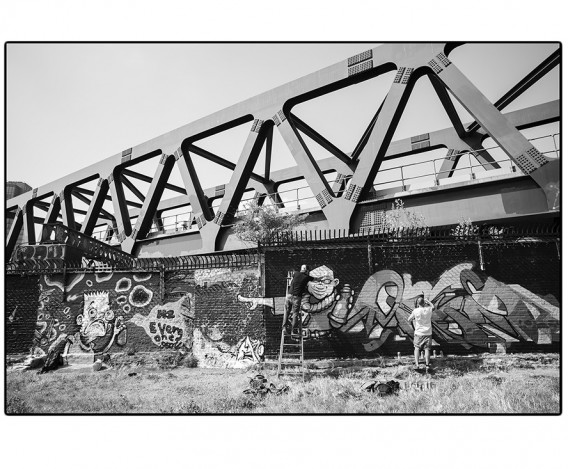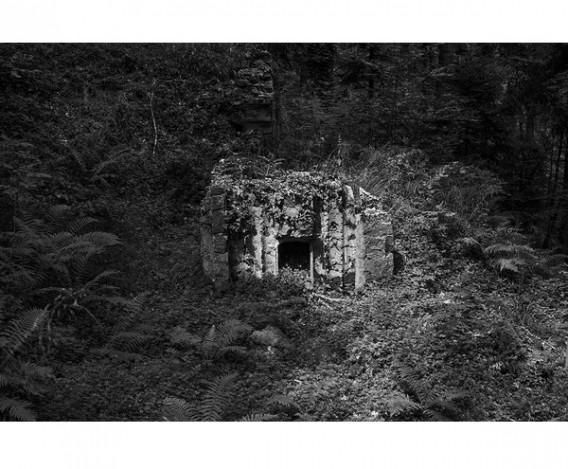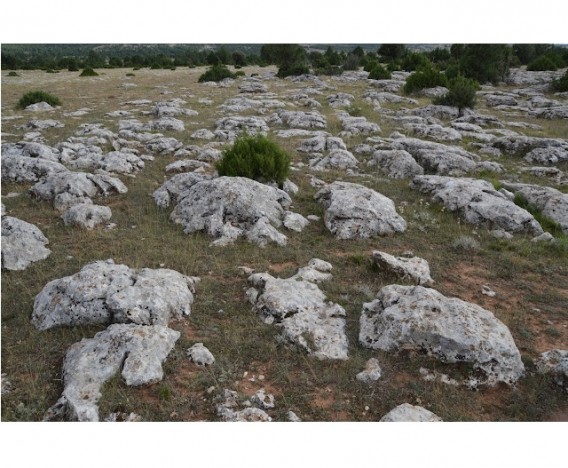There is nomadic life around us. Sometimes as an echo of the past. People who have not been integrated into our form of social organization around paid work.
The works exhibited in the exhibition “The Nomadic Life” reflect the existence of this phenomenon. Which refers both to those who appear portrayed and to those who portray them (even if only part-time).
On the other hand, during the research work for the staging of this exhibition, it has become clear that nomadic life today takes place in urban spaces with very precise characteristics. These are empty spaces without a predetermined function. In the middle of the functionalist city engineered a century ago, where everything is supposed to be calculated down to the millimeter, the truth is that spaces have appeared that look like no man’s land in which freedom can flourish. They are the spaces around and below large urban infrastructures; the empty spaces generated by the application of urban standards (the more buildable, the more empty space) in which it is not possible to recognize sidewalks or parks, sometimes they end up being converted into playgrounds for skaters. And large areas of land that housed industrial activities that are now obsolete and that, after several changes of use (often only on paper), end up becoming wild areas, where nature recovers the role it had long ago, and children the possibility to have a genuine affair.
In this context of inquiry into the landscapes of nomadic life, we became aware of an overwhelming landscape that immediately suggested an epic wandering life. It is the sea of stones of Arroyo Cerezo (Rincón de Ademuz). And indeed it has been the scene of wandering lives, because we are talking about the territory of the Maquis (the anti-Franco resistance during the dictatorship of General Franco), and before the Carlists (who did not recognize the legitimacy of Queen Elizabeth II of Spain and fought against the liberal monarchy). When it ceased to be a center of power, a condition that came from the function of this territory as a containment border of the Islamic world, it has later become a backcountry of the existing contemporary power centers on the coast, in which urbanites can imagine wandering for a few days. And, the sea of stones that extends from Arroyo Cerezo to Alobras (Teruel), is a privileged witness of this.
The exhibition “The Nomadic Life” includes the following works:
― Joost Conijn: “Siddieqa, Firdaus, Abdallah, Soelayman, Moestafa, Hawwa in Dzoel-kifl”, audiovisual, in Amsterdam, 40’, 2004.
― Denis Ponté: from the series “Nomadic Community Garden” (2018) and “Left for Dead” (1994), photography, in London and New York.
― Toni Serra aka Abu Ali: “Al Barzaj” [“Between Worlds”], video, in Marrakesh, 13’, 2010.
― Ulrike von Gültlingen: “Hohrodberg”, photography, in Alsace, 2021.
― Enrique Gil Bazán: “Sea of stones”, photography, in Arroyo Cerezo (Rincón de Ademuz), 2015.
THE AUTHORS
Joost Conijn (1971, Amsterdam)
His activity unfolds halfway between technology and art. He is an inventor and adventurer. Among other things, he has built airplanes, using bicycle parts. The first crashed shortly after takeoff, but with the second it traveled to Kenya. He has toured various countries in Eastern Europe with a vehicle made of wood that runs on gas generated by the vehicle itself. He has made movies narrating these adventures. Among others, one about his trip by bicycle through Morocco with two friends.
His works and vestiges of his adventures and his inventions are in the collections of the Franz Hall Museum in Harlem (The Netherlands) and in the Museum Boijmans Van Beuningen in Rotterdam. His works and experiences have been shown in art spaces around the world: Royal Athenaeum of Antwerp, in 2017; Kyoto Municipal Museum of Art, in 2015; 13th Istanbul Biennial and Biennale of Sydney in 2014; Museum Volkenkunden Leiden (NL) in 2013; Kröller-Müller “Art Cars” Utrecht and Triennale de Paris “Intense Proximité” in 2012; Matadero Madrid in 2009; WORLD MAP ’08 Pamplona in 2008; Cobra Museum (Solo exhibition), Amstelveen (NL) in 2005; Miro Foundation (Solo exhibition), Barcelona, in 2005; etc.
Denis Ponté (1964, Geneva)
A photographer who combines his work in the studio with his teaching activity at the University and his travels around the world, capturing what his eyes see in a very direct way.
Throughout his career, Denis Ponté has developed numerous artistic projects with a social theme. Some of his most representative works are: “Laissé pour mort” (Geneva, 1995), “Face à Elle” (Geneva, 2015); “I understand. Do you?” (Cairo, 2016), “Portraites parlés” (Martigny, Valais, Switzerland, 2019), “Facing them”, La Posta Foundation (Valencia, 2019), “Homo Artifex”, Bancaja Foundation, Sagunto, 2021 (includes video-interviews). In addition to his photography, he shares his experience in workshops held in West African countries.
Toni Serra / Abu Ali (Manresa, 1960 – Barcelona, 2019)
In their career, as in their lives, they have coexisted with a critical attitude, which includes relevant texts such as “Open the vision”, with audiovisual works that have sought to create another imaginary, different from the one that constantly invades us through the media, including the cinema, some audiovisual works steeped in spirituality, even religiosity, remarkable.
Toni Serra passed away suddenly in 2019 in Barcelona, after a life from here to there, both in a physical and mental sense. The fact that he adopted a middle name ―Abu Ali― is quite significant in this regard. Abu Ali means “son of Ali” in Arabic. Toni Serra lived a lot in Morocco. Before he lived in New York, between the end of the eighties and the beginning of the nineties, but as part of his training as a video artist. Although also in the United States, his side of political criticism coincides with his search for new imaginaries (in this sense, his work “The song of the hoopoe”, published in 2015, is paradigmatic, although with images recorded in evangelical churches during his stay in New York at early 1990s). That being in one place or another can be appreciated even in his early formative phase, when as a young man he studied Art History, which are literary studies, but after graduating he went to New York to learn video art. A life “between worlds”. That is why the choice of “Al Barzaj” [“Between worlds”] (13’, 2018) is particularly appropriate, in particular for “The Nomadic Life”.
Ulrike von Gültlingen (Bielefeld, 1966; lives and works in Berlin)
She has developed her artistic career in the field of photography, drawing and stage design. In 2004 she founded the Freiraum School of Arts in Berlin, of which she is the director. Within Freirarum [outdoor space] she created Freirarum-kinder e.V., a non-profit association, with the aim of giving children free access to art and culture and promoting their creative thinking and potential.
About the series of photographs “Hohrodberg”, made in Alsace, the artist has commented: “I love wandering, discovering places that are more than themselves, the apparently random things that follow a secret principle of human legacies, telling us stories or asking us riddles”. Because, effectively, the places portrayed hide a secret.
Enrique Gil Bazan (Zaragoza)
He is a geologist and paleontologist (he was part of the Atapuerca team ―linked to the Museum of Natural Sciences in Madrid―, which under the direction of Emiliano Aguirre received the Prince of Asturias Award in 1997), and also a novel writer (Homo Project. Atapuerca: under the threat of the international plot, Certeza Libros, Zaragoza, 2007; a novel of intrigue, action and suspense), and writes scientific popularization in different media, such as CatalunyaVanguardista – Digital Independent. He uses photography to illustrate his scientific work with images, as before drawing was used for that purpose. His photographs of the sea of stones of Arroyo Cerezo, in Rincón de Ademuz (Valencia, Spain), show us a landscape of undiscovered beauty, to which his work makes a notable contribution.

The Nomadic Life. The Exhibition Guide
“The Nomadic Life and the place of Rincón of Ademuz”. Colloquium



![Toni Serra / Abu Ali: “Al Barzaj” [“Entremundos”], 13’, 2010.](http://fundacionlaposta.org/wp-content/uploads/2022/10/barzaj_diptic_recortado2.2-568x469.jpg)

